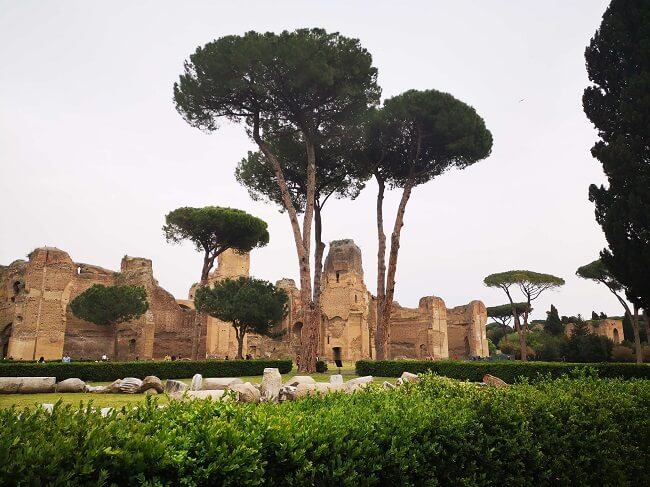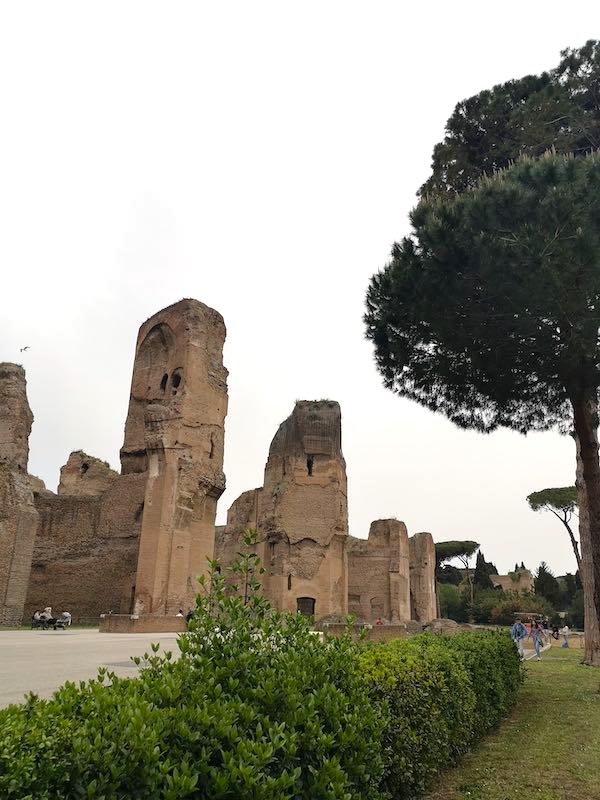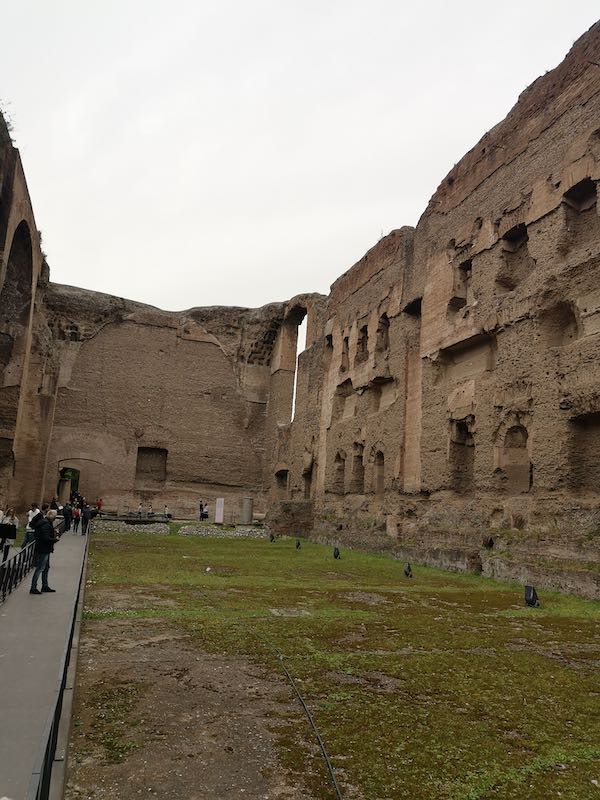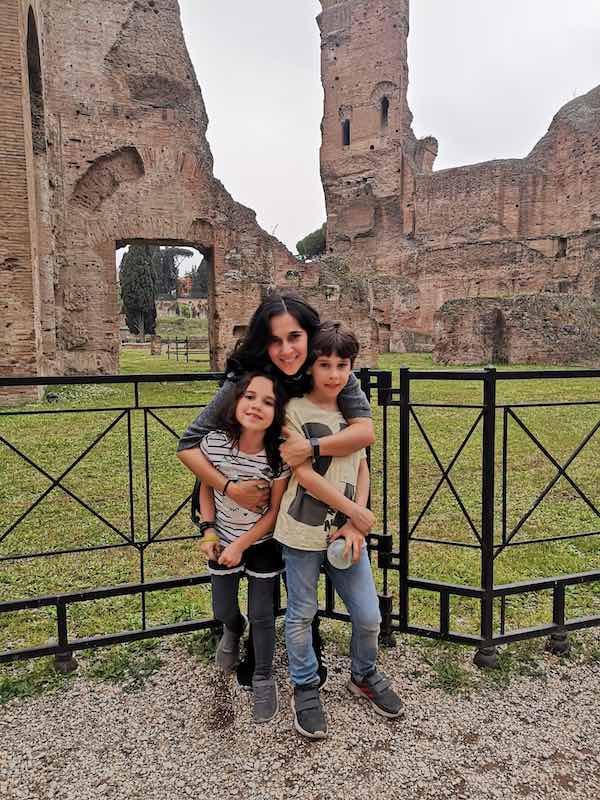All you need to know to plan a visit to the Baths of Caracalla (Terme di Caracalla), one of Rome’s most impressive ancient sites.
The Baths of Caracalla (also known as Caracalla’s Baths, Thermae Antoninianae or Terme di Caracalla) are a colossal thermal bath complex dating back to the III century AD and one of the most impressive and beautiful sites in Rome.

Rivaled in beauty and size only by the Colosseum and the Palace of Emperors on the Palatine, both a short walk away from the baths, the complex was closed to the public for many years and maybe because of this, it hardly ever appears in classic Rome itineraries.
However, it never fails to impress those who do go see it and I personally highly recommend a visit.
The feel of this place is very different from that of the Colosseum and the Forum and will no doubt add to your Rome experience. It is also one of the not many places to see ancient mosaics in Rome.
Please note: this post contains affiliate links and, should you make a purchase through them, we might make a small commission.
What is special about Caracalla’s Baths
Caracalla’s Baths are a beautifully preserved example of an ancient Roman Thermal Bath Complex.
They were built by order of Emperor Caracalla between 212 and 217AD and, at the time, could host over 1600 people.
At the time of their constructions, the baths were the biggest ever built in the Empire and they stayed the biggest until about a century later, when Emperor Diocletian built its own baths, in the area of now Piazza della Repubblica and Termini Station.
You can read all about Diocletian’s Baths here.

It took 9000 workers and over 5 years to build the baths and they remained in use until 570AD, when Vitige, Kings of the Goths, cut off the water supply to the city to advance his siege.
The size of the Baths of Caracalla and the impressive heights of the tall walls, still standing, make this place unique for visitors.
Much more than in the Roman Forum, here it is possible to appreciate the mastery of Roman builders, the expert use of bricks, that of arches and vaulted ceilings and still imagine how it must have felt like to move between the several spaces that make up this site.
The beautiful outdoor spaces of the baths and the remains of the mosaics that once adorned them make this one of the most evocative, beautiful and charming monuments in the whole of Rome.

How to get to Caracalla’s Baths
The Baths of Caracalla are located in Rome city center, a short walk from the Colosseum (about 10 minutes), the Circo Massimo and the Aventine Hill (see below).
The nearest metro stop is Metro B Circo Massimo.
Tram n.3 serves this area, with a handy stop at Circo Massimo/ FAO, the main modern landmark of this area.
Closest bus stops are: 628 and 760.
The official address of the baths is Roma, Viale delle Terme di Caracalla, 52.
Baths of Caracalla’s Tickets
2021 Updates: please be advises that from September 2021 access to cultural venues in Rome, even outdoor ones such as Terme di Caracalla is subject to showing a valid ‘Green Pass’. You can read official rules about it here.
Due to recent events, tickets to the baths of Caracalla must be booked online in advance: you can find the official ticket office here or book a guided tour of the Baths here – the advantage of the guided tour is that it comes with a good cancellation policy which the official and cheaper tour lacks.
Temperature checks are carried out upon entering and only people with a body temperature below 37.5 are admitted to the site.
Inside the complex, it is compulsory to wear a mask (also outdoors, at the time of writing) and to observe social distancing – this is usually rather simple here, thanks to the large open-air nature of the site and a new indicated one-way path around the site.
Hand sanitizer is provided at several locations on site.
Visiting Caracalla’s Baths: what to expect, what you cannot miss
The Baths of Caracalla are a large complex with rectangular planimetry, typical of great imperial bath houses.
The baths were not just meant for bathing but rather as a vast center and meeting point for physical wellbeing, walks and study, a layout that is very easy to appreciate even today.

The main thermal building is at the center of the complex and hosted the calidarium, tepidarium, frigidarium and the natatio, respectively the hot, warm, and cold bathing areas.
At the two sides, in perfect symmetry, there were the 2 gymnasiums and the changing areas and on the external perimeter, there were cisterns, libraries and several tabernae (shops).
The baths were fed by a new branch of the Aqua Marcia Aqueduct called Aquae Nove Antoniniane and the warmth was guaranteed by a complex system of underground network tunnels that allowed the movement of hot steam and acted as a heating system.
All these areas are easy to see during your visit. As you enter the complex, you find yourself in a large open air space that allows you to appreciate the magnitude of the complex in front of you.
From here, you can wander in between the tall walls and experience the feel of the different areas of the baths, each now equipped with short info panels explaining their original use. (Please note: in 2020, you need to follow a pre-ordered one-way path, signposted. Prior to that, there was no defined order for your visit)

For the most part, the walls are now of exposed bricks, beautiful in their own way, but many mosaics and decorations are on display and allow to imagine how the baths must have looked like.
Some drawings of the baths as they used to look are on show in several parts of the baths and they show us that the complex would have also been decorated with colorful marbles, columns and statues.
It is interesting to notice that some of the sculptures from the baths are now part of important art collections such as the Farnese collection and are displayed in several museums around Italy and at the Vatican
The state of conservations of the different areas varies but some of the most intact spaces still have floor mosaics worth seeing and interesting remains such as Tabulae Lusoriae that the Romans used to play marbles!
What to wear to visit the Baths of Caracalla
The baths of Caracalla do not pose particular mobility issues and no not require special equipment.
Like for all archaeological sites, I recommend you wear good walking shoes that will support your feet however, the pavement here is more even than at the Forum or the Palatine.
At the time of writing, there was no cafe or food outlet at the baths however, we did see a drinking fountain. Please note that it is forbidden to consume food in the complex.
Visiting the Baths of Caracalla with kids
The baths of Caracalla are one of the easiest and best Roman sites to visit with kids.

Beautiful and outdoors, it is a place where toddlers can easily and safely run around and a location easy to enjoy for older kids too.
The record breaking size of the site tends to capture kids’ imagination and a specific spot within the baths tends to leave an impression: in the corner of one of the baths, you can still see a tabula lusoria, the board Romans used to play ‘marbles’!
The site is stroller friendly and there are restrooms on site as well as a drinking fountain.
There is not, however, food on site: the closest set of shops is on Viale Aventino, a few minutes walk towards Circo Massimo.
See a concert at Caracalla’s baths
The Baths of Caracalla in summer turn into one of the most spectacular theaters you can ever ask for, thanks to the Rome Opera Theater, that uses the space for opera and, sometimes, other concerts.
The experience to see the Opera at Caracalla is magical, the calidarium being a unique and impressive backdrop. If you can, try and see here a big opera production (the Aida or Nabucco for instance), that are exceptionally suited to such an incredible location.
In 2020, concerts here were suspended: check the Opera House official calendar here for updates. Usually, Caracalla’s season runs during the month of June – July –August.
Fun fact: The Baths of Caracalla are the impressive backdrop to some beautiful scenes in the Woodie Allen’s film ‘To Rome, with love’. Find more movies set in Rome here.
What to see nearby
Close to the Baths of caracalla you will find:
- Colosseum
- Palatine Hill and Roman Forum
- Circo Massimo/ Circus Maximus
- Aventine Hill
- Garden of Oranges
- Mouth of Truth
- Arco di Giano (Janu’s Arch)
- Rome’s Pyramid
- Testaccio
- The train to Ostia Antica
I hope you enjoyed this quick overview of the Baths of Caracalla and it inspired you to add to your Rome itinerary. Safe travel planning!
